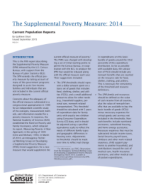The Supplemental Poverty Measure: 2014
The Supplemental Poverty Measure: 2014
Introduction
This is the fifth report describing research on the Supplemental Poverty Measure (SPM) released by the U.S. Census Bureau, with support from the Bureau of Labor Statistics (BLS). The SPM extends the official poverty measure by taking account of many of the government programs designed to assist low-income families and individuals that are not included in the current official poverty measure. The current official poverty measure was developed in the early 1960s, and only a few minor changes have been implemented since it was first adopted in 1969 (Orshansky, 1963, 1965a, 1965b; Fisher, 1992). The official measure consists of a set of thresholds for families of different sizes and compositions that are compared with before-tax cash income to determine a family’s poverty status. At the time they were developed, the official poverty thresholds represented the cost of a minimum diet multiplied by three (to allow for expenditures on other goods and services).
Concerns about the adequacy of the official measure have increased during the past decades (Ruggles, 1990), culminating in a Congressional appropriation in 1990 for an independent scientific study of the concepts, measurement methods, and information needed for a poverty measure. In response, the National Academy of Sciences (NAS) established the Panel on Poverty and Family Assistance, which released its report Measuring Poverty: A New Approach in the spring of 1995 (Citro and Michael, 1995). In March of 2010, the Interagency Technical Working Group on Developing a Supplemental Poverty Measure (ITWG) listed suggestions for research on the SPM. The ITWG was charged with developing a set of initial starting points to permit the Census Bureau, in cooperation with the BLS, to produce a report on the SPM that would be released along with the official measure each year. Their suggestions included:
- The SPM thresholds should represent a dollar amount spent on a basic set of goods that includes food, clothing, shelter, and utilities (FCSU) and a small additional amount to allow for other needs (e.g., household supplies, personal care, non-workrelated transportation). This threshold should be calculated with five years of expenditure data for families with exactly two children using Consumer Expenditure Survey data, and it should be adjusted (using a specified equivalence scale) to reflect the needs of different family types and geographic differences in housing costs. Adjustments to thresholds should be made over time to reflect real change in expenditures on this basic bundle of goods at the 33rd percentile of the expenditure distribution.
- SPM family resources should be defined as the value of cash income from all sources, plus the value of noncash benefits that are available to buy the basic bundle of goods (FCSU) minus necessary expenses for critical goods and services not included in the thresholds. Noncash benefits include nutrition assistance, subsidized housing, and home energy assistance. Necessary expenses that must be subtracted include income taxes, Social Security payroll taxes, childcare and other work-related expenses, child support payments to another household, and contributions toward the cost of medical care and health insurance premiums, or medical out-of-pocket (MOOP) costs.
This report presents a poverty measure that is based largely on the NAS panel’s 1995 recommendations and reflects more recent research and suggestions from the ITWG. Particular emphasis is on internal consistency between the thresholds and resources. The NAS panel noted: “It is important that family resources are defined consistently with the threshold concept in any poverty measure.” The SPM, as defined by the ITWG, is an internally consistent poverty measure that is based on spending “outflows” and money “inflows.” Spending outflows, or outlays, are those for basic needs only: FCSU and other basic necessary goods and services. Resources include money income from all sources plus the value of noncash benefits that help the family meet spending needs, less necessary expenses, like work-related expenses and taxes that must be paid. A family is designated as poor if its annual money inflow, net of necessary expenses, falls below its threshold level of money outflow.
The SPM does not take account of assets that may be used to meet necessary expenses. Since assets can add to the resources that are used to meet basic needs, some analysts advocate counting them in measuring poverty. Others may argue that many assets are not liquid or suggest that poor families have so few assets that including them would not change poverty measures much. If our purpose is to target families who are in need, then it is clear that families with no assets are worse off than those who have some. On the other hand, families who have incurred large debts are more vulnerable to financial trouble than those who have not. The NAS panel discussed a “crisis definition of resources.” This definition included those assets families have on hand that could be converted to cash to support current consumption. They suggested that this “crisis definition” is only relevant for a very shortterm measure of poverty because, in their words, “…assets can only ameliorate poverty temporarily.” They suggested that it is important, however, to develop measures of the distribution of wealth and to examine the relationship between asset ownership and poverty status. While spending down assets can enhance income to make ends meet, servicing debt can be a drain on family income that would otherwise be sufficient to purchase basic necessities.
The ITWG stated that the official poverty measure, as defined in Office of Management and Budget (OMB) Statistical Policy Directive No. 14, will not be replaced by the SPM. They noted that the official measure is sometimes identified in legislation regarding program eligibility and funding distribution, while the SPM will not be used in this way. The SPM is designed to provide information on aggregate levels of economic need at a national level or within large subpopulations or areas and, as such, the SPM will be an additional macroeconomic statistic providing further understanding of economic conditions and trends.
This report presents updated estimates of the prevalence of poverty in the United States, overall and for selected demographic groups, using the official measure and the SPM. Section one presents differences between the official poverty measure and the SPM. Comparing the two measures sheds light on the effects of noncash benefits, taxes, and other nondiscretionary expenses on measured economic wellbeing. The composition of the poverty populations using the two measures is examined across subgroups to better understand the incidence and receipt of benefits and taxes that are missed in the official statistics, and the distribution of income-to-poverty threshold ratios are also estimated and compared for the two measures. The second section of the report examines the SPM itself. Effects of benefits and expenses on SPM rates are explicitly examined, and SPM estimates for 2014 are compared with the 2013 figures to assess changes in SPM rates from the previous year.
Others in Series
Publication
Visualization
Publication





